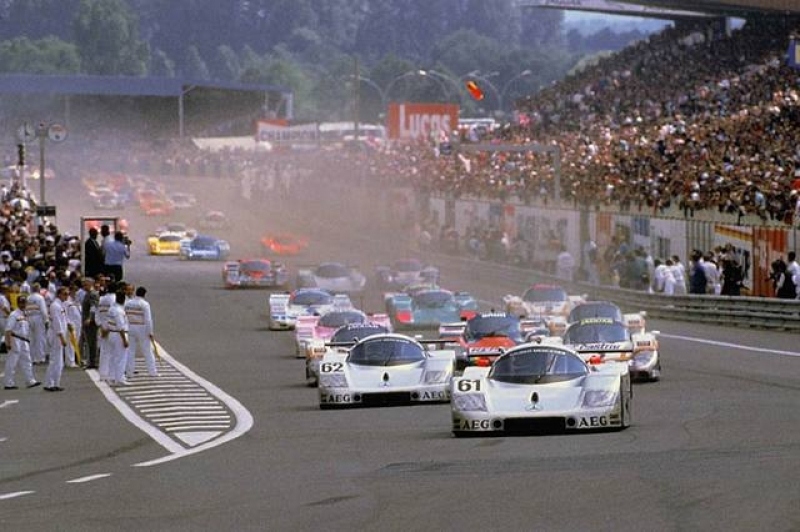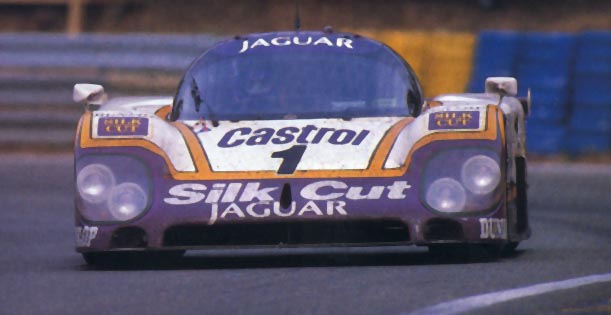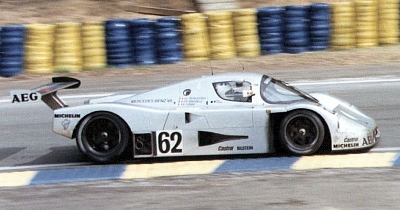|
|



Starlight Express - Qualifying |
by Quentin Spurring and Adam Cooper. It was a result no one really expected. The Jaguars ran quicker than ever before, but broke, while Peter Sauber's Mercedes-Benz scored a magnificent 1-2-5, the Silver Arrows matching pace with reliability which stunned even the team's own hierarchy. It was a great and well-deserved win for veteran Jochen Mass and co-driver Stanley Dickens and Manuel reuter, who didn't put a fott wrong. after last year's public disappointment, Mercedes had made its point... |
Le Mans and J.-L. Schlesser. You know the story. It's not even a love-hate relationship: it's a hate relationship. This is a race he loathes! Last year, he even declined to participate for Sauber Mercedes, became a TV commentator instead for the weekend. 'Schless' reckons Le Mans is too long and too fast and altogether too ensnarled by inescapable hassle and hype. This year, looking at maybe only eight events in the World S-P Championship (and all scores to count), Jean-Louis agreed when asked once more to do the race by Sauber team manger, Max Welti. Six weeks before the Le Mans weekend, it was withdrawn from the World Series, but Schlesser felt he could not let Welti down. He stood by his commitment. Evryone knew he would rather be doing something else. his heart wasn't in it. But wait a minute.... Who was this, lights blazing on his Silver Arrow, storming the Mulsanne Straight at 250mph? Swinging through the Mulsanne corner, and hurtling off towards Indianapolis and Arnage? Getting within a second or so of Hans Stuck's track record, on only his first set of Q-tyres? Well, it was Schlesser, of course. And what did he have to say about it? "The car is good; so fast! Too fast for me!" "You know I did this time with a misfire? Over 5000 revs, there was an electronic misfire." He made a viberating noise with his tongue. "And I went too quick into Indianapolis. I lost some time there, for sure. Then I was held up by the Cabin Nissan in the Porsche Curves. So it wasn't a very good time, you know? Maybe I could have gonde 5 seconds faster! I mean it...!" No sooner was Schlesser out of the car, and smilingly telling his tale, than the heavens opened, there was a sudden, heavy tunderstorm. The first of the four qualifying sessions was red-flagged when five cars - the last five out on the track at the time - went off the road. The second session was started early but the track remained damp until well into the darkness. Schlesser had not only been the first amn to come hot before the rainstorm, he had been the only one. And he found himself with the overnight pole. For the record, John Nielsen's Jaguar was second fatest on the first night, followed by Kenny Acheson's sauber, Jan Lammers's Jaguar, Jochen Mass's Sauber and Geoff Lee's Toyota. But none of these men had yet driven in anger. What we had here, therefore, was a Le Mans in which Thursday's two qualifying sessions assumed an unusual air of urgency and, as it evolved, staged good drama for a big crowd of sunbathing spectators. No way was Schlesser going to be allowed to go unchallenged for the pole, there were half-a-dozen drivers eager to take a crack at him. For the main challenge, we looked to the other Saubers, to the awesome turbo boost of Toyota, and also to the skille of Hans-Joachim Stuck, the track record holder himself. If you had thought there would be six factory teams at Le Mans 1989, think again, and make that seven. Joest Racing's pink Porsche was not an official entry in name, but this car had every appearance of one with rather more than factory blessing. That man with the headphones in the Joest pit, surely, was Norbet Singer - the accomplished Porsche TM who has been imtimately involved with seven victories here by the works team. And the man tending Team Schuppan's Omron Porsche, come to that, looked very similar to Klaus Bischoff. Anyway, back to Hans-Joachim Stuck. The car had popped its engine on Wednesday evening (the Dijon-winning unit, installed for the qualifying effort), and Bob Wollek had been only ninth fastest when it happened. Now we expected the Joest bid for the pole, and those of Toyota and maybe even Jaguar. All was quiet for the first hour or so, asve for "Popi" Larrauri, whose Brun Porsche had been smitten by a Motronics misfire the night before, putting in a low 3m20secs. Then Geoff Lees signalled the Japanese intentions with a low 3m17secs. On his second set, Geoff slipped under the track record with a 3m15.51secs, and the chase was on. Like Schlesser, Lees had a disarming response to questions about the lap. "Disappointing," he said. "Yes, really, I came across some car in Tertre Rouge (a C2 ALD that had gone off in the Esses), crawling round shedding things with sparks coming off them. It was right on the apex and there was something else going around the outside. I had to go all the way round both of them and, I tell you, I almost came to a stop. There's 4 more seconds in this car, definitely!" Down at Joest Racing, bynow, Stuck was girding his loins for his own hot lap, but it turned out that the team nurtured an ambition merely to improve its grid position, rather than to topple anyone off pole. The Q-engine had been replaced not by another, but by the race engine, and Hans-Joachim was allowed only 1.25 bar boost pressure, instead of the 1.5 he would normally have for a pole effort. Stuck was off the pace on his first set of Goodyear's softest, and could only just get below 3m20secs on his second. His story:"First time out, I was just getting myself into the groove - remember, I haven't driven a Group C Porsche for a long time. On the other set, one tyre went off after only half a lap, but I did the best I could. I had some traffic, too, but I enjoyed it. Very much!" Suddenly, along came Joens. And Jaguar, even without a turbo. The best lap time in a Jaguar in 1988 had been driven by Martin brundle, in 3m21.78secs. Yet here was Davy Jones, back in the pits and smiling ear to ear, having driven a mid-3m19secs with hardly the most ideal lap. "I was baulked twice in the Porsche Curves," reported Davy. "Frist I went for the inside, and he chopped across, then the outside, and he did it again. There's still more to come." As if to prove the point, Jan Lammers went even better in one of the sister cars a few minutes later, again despite some traffic. And both Alain Ferté (an impressive recruit for Jaguar, especially in the damp the previous night) and John Nielsen got within a second or so of Jones's lap time. As to the other Saubers, Jochen Mass's bid was halted by a broken fifth gear pinion - ominously - but Mauro Baldi put the Jaguars in their place with a determined attack on the track record. He just missed it, but Mauro, surely, would be pleased with his performance. "I'm pissed off," he said. "I was blocked just before Indianapolis, but it was still a good lap. You try to do your best, and you miss out by threehundredths of a second! What can you do?" Mauro's effort, with his race engine, took him down the chute at 236mph, and it was clear that the Saubers and the Jaguars were evenly matched for pace. All four Jaguars were quick, the fastest being Jones's at 240mph. Only one of the Project 400 WM-Peugeots (241) and Schlesser's Mercedes were faster - unless you count Lees's Toyota. And there was the problem with Toyota's effort. Geoff's lap time remained fastest at the end of the third session but, buring the one-hour break in the action, there was a lot of discussion about whether he would be able to claim it. In fact, Toyota had surprisingly made the same mistake it had made at Fuji in 1986, when Satoru Nakajima's pole lap had been disqualified because it had been set in a T-car. And there was no denying that Lees's yellow 89C, cooling of in the pits, had a "T" next to its 37. The rule is clear: a T-car can be used for the race, but only if it replaces a nominated race car, and starts from that grid position. Lees's performance had made a point for Toyota: only that. Going into the final two-hour session, therefore, we had Baldi on pole with Lammers alongside, and we had heard nothing yet from Schlesser. But he wasted no time in putting that right. |
Schlesser: "The car is good; so fast! Too fast for me!" |
Lees had a dis- arming response to his quick lap |
'Schless' swiftly warmed up the car on race tyres, came in for softer rubber, zinged down the straight again, and came close to 3m14secs. THen he came back to the pits, drove straight through them to the paddock gate, manouvred his Silver Arrow into its paddock enclave, and got out as a mechanic zipped up the tent. By 8.20, he had his feet up again. So absorbing had been the battle for the Le Mans pole that it came as a surprise and something of an anticlimax that, in the end, it was so convin- cingly won. Neither of Toyota's V8 race cars was in qualifying configuration, and Silk Cut Jaguar settled for what it had: the second row, behind an all-Mercedes front. Behind, it would be Porsche-Jaguar, Porsche-Jagauar, and the two Porsches that filled out top 10, namely the Brun team's From-A car qualified by Sarel van der Merwe, and the Kremer team's Leyton House entry in the hands of George Fouche. Aside from the various pole postion bids, a feature of the Thursday practice was a startling improvement by Nissan, whose Wednesday had been spoiled by a whole series |
of problems. Martin Donnelly at Last found some speed on the straight and came along with a low 3m24secs, placing his Nissan on sixth row, alongside the third Sauber Mercedes. Three places behind, after Frank Jelinski's Joest Porsche and Giovanni Lavaggi's Kremer car, came the sister Nissan driven by Geoff Brabham, the IMSA champion (like Martin himself) and enthralled Le mans debutant. Toyota's mistake with the T-car meant that the company was outqualified not only by Nissan, but by Mazda, too. Takashi Yorino - a Le Mans veteran now - produced a very smart lap time from the best of the 767C sewing machines and, in doing so, pipped Lee's Wednesday result. The other factory team was struggling to find any kind of Le Mans form. The Aston Martin AMR-1 was mite faster on the straight than the Emka had managed in 1985, at 211mph, but the new car - the noisiest in the place - was far away from a competitive lap time. The much-fancied RLR Porsches were very disappointing in a straight line, the team not having been able to any high-speed track-testing with its low-downforce package. The car with which Derek Bell would try for a sixth victory here could qualify no higher than 23rd. The Cabon Porsche had also been one of those that had crashed on Wednesday evening when Tiff Needell, creeping pitwards in second gear as the rain fell, was suddenly confronted by a wall of water on the run up to the Ford Chicanes. Instantly, all control went away, and the red car slithered off the track into the barrier, also striking the Prototeam C2 Spice that had already spun off. Behind, Lavaggi came on the scene with the Kenwood Porsche, and also spun. In one of the C1/3.5 Spice-Fords, Wayner Taylor saw all this and spun deliberately to avoid the mess, ending up on the grass. Taylor was just getting out of the car when, to his horror, he caught sight of one of the Mazdas, driven by Marc Duez, fishtailing out of control towards him. Wayne urgetnly reoccupied the cockpit and the Mazda struck the Spice. Both men emerged unhurt, save for Taylor's abdly bruished arm, and the cars and the Cabin Porsche were all repaired in time for the Thursday sessions thanks to some fine work by the crews involved. No such incident occurred on the second day, which was happily free of serious mishaps. On Friday, as the mechanics toiled, the samrt money was going on the pacy Jaguars and Joest Racing's pink Porsche. No one really believed that the C9s would remain strong through their first 24-hour race. |